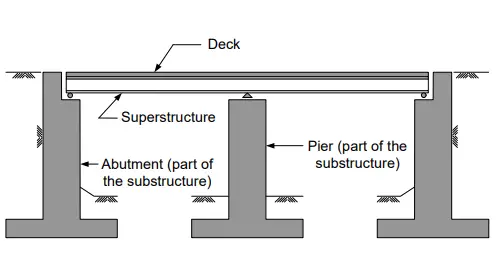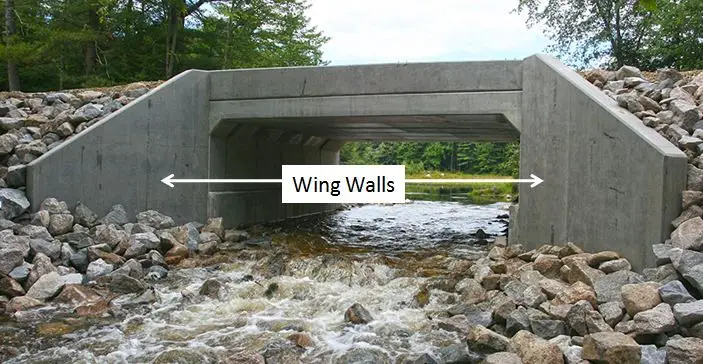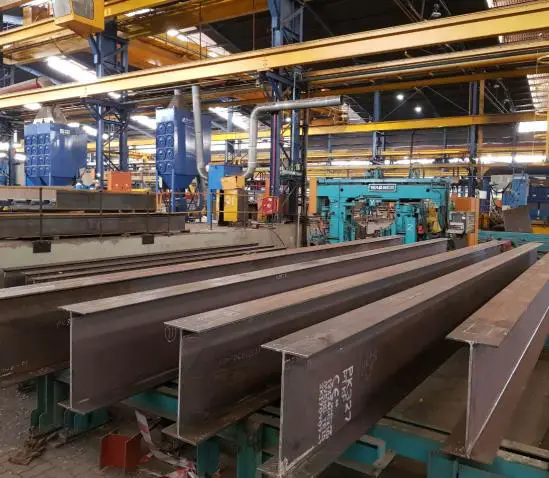Parts of a Bridge | Abutment | Bridge Piers | Wing Walls | Deck | Bridge Bearing
Parts of a Bridge | Abutment | Bridge Piers | Wing Walls | Deck | Bridge Bearing
What is Bridge
A bridge can be defined as a structure mainly constructed to support the road, traffic, or other moving loads over a deep valley or obstruction, such as a river, railway, channel, or another road.
Types of Bridge Designs
-
Tied Arch Bridge
-
Cantilever Bridge
-
Arch Bridge
-
Beam Bridge
-
Suspension Bridge
-
Truss Bridge
-
Cable-stayed Bridge
Other Bridge include
- Through arch bridge
- Viaduct
- Box girder bridge
- Clapper bridge
- Covered bridge
- Girder bridge
- Integral bridge
- Extradosed bridge
- Moon bridge
- Movable bridge
- Pigtail bridge
- Pontoon bridge
- Rigid-frame bridge
- Roving bridge
- Segmental bridge
- Self-anchored suspension bridge
- Step-stone bridge
- Stressed ribbon bridge
- Suspension bridge
- Transporter bridge
- Trestle
- Covered bridge
- Tubular bridge
Importance of Bridges
- Bridges save time and fuel.
- Bridges help in faster delivery of goods and service hence helps in the economic development of the area
- They are built so that Road or railway traffic can run uninterrupted in monsoon
- Bridges reduce the distance between two locations
- Construction of a bridge on railway alignment at level crossing reduces the number of accidents.
- Bridges can improve the aesthetic of a road.
- Bridges can be important from a military point of view.
Parts of the Bridges and their Functions:
Bridge parts can be categorized into two, namely:
- Bridge Substructure
- Bridge Superstructure
Bridge Substructure
Bridge substructures are the components of the bridge below the bearing level. The bridge substructure components’ main function is to support the bridge superstructure components like deck and transfer bridge loads safely to the foundation.
Bridge substructure Components include:
- Bridge Abutments
- Bridge Piers
- Bridge Wing Walls
Bridge Abutments
Bridge abutment consists of vertical structures designed to retain the earth behind the bridge structure. The abutments also provide much needed additional support to the live loads and dead loads from the bridge.
Bridge Abutment is mostly used for the bridge as well as in the dam at the ends of a bridge span or dam and stands below the superstructure.
Most Bridges with a single span have two abutments that give lateral and vertical support. Bridge Abutment plays an important role in retaining walls to resist lateral movement of the bridge approach’s earthen fill.
Bridge Piers and Pier Caps
Bridge piers are raised structure that sits in a body of water in order to support a bridge. Piers provide intermediate support between two bridge spans. The open structure of a pier allows water to pass through it, preventing pressure from building up against it.
Bridge piers transmit the bridge load to the foundation.
Pier caps (headstock) are used as a space for girders in order to transfer loads on bearings from the superstructure components on the top.
Bridge Wing walls
The bridge wing walls are the substructure components extending the bridge abutments to retain the earth in the approach bank. Wing wall retains soil for roadway, abutment, and approach embankment, which can be at a right angle to the abutment or done at different angles.
The wing walls are the additional retaining walls constructed adjacent to the abutments.
Bridge Superstructure Components
Bridge superstructure components mean the bridge parts that are above bearings. The main purpose of the bridge superstructure components is to successfully support the live load and the dead load imposed on them and transmit that load to the bridge substructure components.
These superstructure bridge components mainly comprise of the following:
- Bridge girder or Beams
- Bridge Bearing
- Bridge Arches
- Bridge Cables
- Bridge Handrails
- Bridge Parapet walls
- Bridge Decks.
Bridge Girders or Beams
A girder is the main horizontal support beam on a bridge. It is the part of the superstructure which bends along the span that supports the road pavement, thereby preventing it from bending. Beams support the deck. Beams are mostly used in concrete bridges. Girders often have an I-beam cross-section made up of two load-bearing flanges separated by a stabilizing web. Again, they may also have a box shape, Z shape, or other forms.
A girder and beam have a similar purpose of supporting the roadway and preventing bending. Girder is also one type of beam support.
Bridge Bearings
A bearing is between the pier cap and bridge girder and the main purpose of transferring loads from the deck to the substructure. The bearings also stabilize the bridge by allowing vibration or free movement of the top superstructure and reduce effect stress to reach the bridge foundation. The movement can be linear as well as torsional.
A wide variety of bearings have been developed based on several different factors like geometry, types of loadings, and dimensions of the bridge, maintenance criteria, the displacement and deflection, availability of the materials, and financial resources available. Here are some types of bearings used in bridges
- Pin Bearing:
- Roller Type Bearing
- Rocker Type Bearing
- Sliding Bearing
- Pot Bearing
Bridge Arch and Bridge Cables
Arched and Cable are both used for different purposes. Arched are provided in arch bridge construction, while bridge cables are used for suspension and cable-stayed bridges.
As used in arch bridges, the bridge arches assist in resisting the forces acting on the bridge.
The cables in the suspension bridge serve as the tensile element that provides support to the deck and transfer the loads to the supporting towers and anchorages.
A bridge with arches has a lot of strength as an arch can help control the bridge’s safety and load-bearing ability. The quantity of arches and materials used for construction is very important.
A space connecting the bridge pillars and deck beam are called the spandrel. There can be open or closed spandrels depending on the arch design.
An arch is a curved structure that spans an open space. Arch bridges can span vast open areas because they transform the forces affecting them into compressive stresses, eliminating tensile stresses.
. There are three types of arches, namely;
- Fixed Arch,
- A Two-Hinged Arch
- Three-Hinged Arch
Parapet Walls and Handrails
The parapet is a key safety component of a bridge and prevents the vehicle from falling off the bridge’s side. The parapet wall is also important, preventing waste and rubbish from passing below and restricting side views and can act as noise barriers.
The main purpose of the handrails is to serve as the safety component of the bridge. It is a guard rail system used on the sides of bridges to keep people and vehicles from entering unsafe areas or falling off the edge.
Bridge Deck
A deck is a roadway or the rail surface that gets the direct traffic load and allows vehicles and pedestrians in the bridge. The deck includes walking or travel or paths, expansion components, curbs, sidewalks drainage systems, and approach slabs.
A deck can be made of concrete or metals and is supported by the girders or beams, further supported by the piers or deep foundations with caps.
The deck can be integrated into the support structure of the bridge, supported by girders or beams, or suspended by the main structural elements. In some modern bridges, such a cable-stayed bridges, or tied arch the deck is the primary structural support element.




